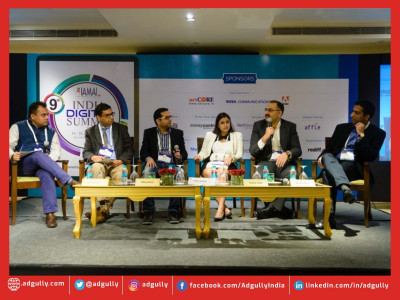Big Tech needs to do a better job of educating users on how their data is being used: Nick Seckold
Mobile ad spends in 2020 grew to $240 billion, up by 26% from 2019, according to State of Mobile 2021 study by App Annie. The report estimates that spend will reach $290 billion by the end of the year. On the side-lines of the 15th India Digital Summit by Internet and Mobile Association of India, Adgully caught up with Nick Seckold, Vice President – APAC, Microsoft Advertising, to understand digital and mobile growth trends driving advertising dollars in the APAC market.
Register for Day 2 of IAMAI India Digital Summit 2021.
Mobile advertising spend is expected to touch $290 billion, according to the latest App Annie report. How will the APAC market contribute to this growth?
The APAC region is obviously several markets and we’ve seen many countries adopt mobile marketing at different speeds. It is true to say that mobile is exploding across the region. In some countries, there has been some issues around connectivity and the affordability of quality devices, but by and large every person in most of these countries, emerging or emerged, now have a mobile phone of some description.
As an example, Indonesia is a market which skipped the PC age and went straight to mobile. Mobile represents a huge opportunity not just as a consumer device, but to small businesses around the world that operate via the mobile. For consumers, it is a device for connectivity and productivity, but from an advertising point of view, it is a way brands can communicate with audiences at scaleand on the go.
Microsoft believes mobile is not just a singular device, but rather, the mobility of experiences. We have built services and experiences on products like Surface, mobile phones, mixed reality headsets, TVs, smart speakers and other types of devices. We believe that you should be able to have access to your information wherever you go.
Search marketing is one of the oldest disciplines in digital marketing. It has become a must have for clients venturing into digital marketing. Has the industry matured or is it seeing new growth trends?
The appetite for search continues to grow. It depends on your definition of search. If you’re talking about search as a destination like a Bing.com, Google.com, then obviously the usage patterns on those destinations have plateaued a bit. But search has evolved and will continue to evolve in the native space, where you can search anywhere, anytime and you don’t necessarily have to go to the search destination. You may be reading an article on a particular publisher’s website and they all have search integrated into their pages. That search bar allows access to the web and those results are being powered by us Microsoft or another search engine. We have seen the rise of different search engines with differing value propositions, be it privacy like DuckDuckGo or sustainability like Ecosia – of which Microsoft helps power the search engine results pages and the advertising for brands on these properties.
Today, we’ve got product search with the rise of e-commerce, where people are searching for products on e-commerce websites like Amazon or on their own shopping platforms. Voice search is also an emerging opportunity. Search is a habit/ behaviour that consumers will continue to use as they navigate around the web. The way that people search is changing as the technology evolves. The behaviour of online search will continue to develop and represents a huge opportunity for growth.
With privacy complaint tracking seemingly an inevitable future, how are you positioned to deliver personalised ads?
Governments around the world are starting to focus on this area to ensure their citizens can navigate the web safely and securely. The Big Tech companies have received a lot of attention in this area because of their dominance, but I think we will end up in a good place, provided Governments work with the industry to legislate in the right way. The Internet has been effectively unregulated since it was invented decades ago. Regulation is not a bad thing, it just needs to be in consultation with the industry so that innovation is not stifled, and we don’t end up in a situation that makes the consumer experience worse.
When it comes to privacy, a lot of talk in the industry right now is around first party data vis-a-vis third party data and whether publishers are asking for consumers’ consent before their house/ store their data and retarget using advertisements. At Microsoft Advertising, we are investing heavily in creating a brand safe environment for brands as the industry prepares for the decline of the 3rd party cookie. Our unique audience intelligence powered by machine learning allows brands to access the millions of consumers who interact in the Microsoft ecosystem every day. Microsoft has historically taken an industry leading approach to privacy and security and will continue to do so, consistent with our privacy principles. At Microsoft Advertising, we adhere to guiding principles that shape the way we build our products and services, including our ad platform, and help reduce the likelihood of any personally identifiable information being compromised. As the use of data increases in our day-to-day lives, we will continue to focus on earning the trust of our customers every day.
I believe the big tech companies and digital publishers need to do a better job of educating users on how their data is being used. There’s a lot of noise around privacy and data usage, which has created a lot of confusion. Documentaries such as “The Social Dilemma” only inflame the situation, so I’d like to see the industry do more to educate consumers. Consumers should feel comfortable and safe in the knowledge that when they go online, the publisher is going to protect their data and not pass it on to a third party without their consent. Since the release of GDPR and CCPA (California Consumer Privacy Act), the industry at large has been forced to revisit their date capture and sharing practices. While initially these policies have been difficult for the industry to absorb, in the long run it’s the right thing to do and drives greater trust and transparency. We believe privacy is a fundamental human right. Our approach to privacy and data protection is grounded in our belief that customers own their own data. We back up this belief with concrete actions to protect our customer’s privacy and give them control over their data. While our products and practices put our customers in control, we recognise the law is still catching up in many places to ensure customers enjoy the transparency and control they rightfully deserve. We have advocated for new privacy laws for several years and we were early supporters of the General Data Protection Regulation (GDPR) in Europe. We were the first company to expand GDPR’s core rights beyond the EU so that consumers everywhere would benefit.
With the rise in online shopping, what is the trend in e-commerce in the APAC region?
If we use Amazon as a proxy, it is clear that consumers around the world have embraced shopping online. A lot of traditional retail brands recognised they needed an online sales channel during the current pandemic as governments around the world imposed strict lockdown measures to combat COVID-19. However, many hadn’t yet invested in the right infrastructure. The challenges in balancing a traditional bricks and mortar business with an emerging, and in many cases, competing online sales channel hadn’t yet been worked through.
Regardless of the pandemic, online shopping is a trend that is here to stay across the APAC region. More and more, retailers are removing the friction once associated with shopping online to ensure their customers have a seamless experience. Of course, this does not mean in-store shopping will go away, it needs to evolve and provide experiences to keep attracting customers. We see this already, where many brands provide a showroom for consumers to touch and feel a product, but orders happen online.
The pandemic has been good for e-commerce as it has accelerated innovation and forced brands to think about their online strategy and how it complements their brick and mortar. More businesses continue to create an online presence to reach new audiences and customers. Online is the great way local businesses and companies with less resources can compete, and we have seen retailers grow their advertising campaign strategies with us, on search, native and our shopping channel.
Marketers are planning to increase digital spends, but which digital platforms will receive the lion’s share?
In most developed digital economies, the percentage of digital media investment is now greater than traditional media. Markets like the UK have been over 60% digital for a number of years as UK consumers embraced the Internet some time ago. Similarly, the US and Australia have crossed over the 50% mark and the same goes for many other markets around the world. Asia, however, has generally been slower in adopting digital as those digital economies emerge. But if the acceleration over the last 2-3 years is anything to go by, it won’t be long before they are right up there with the market leaders.
In my experience, in many countries around APAC there has been some resistance to move a portion of investment away from traditional media channels such as television and press. While traditional media will always have a role in a balanced communication strategy, brands should consider where their audience spend their time and build their media plans accordingly. People still like to sit in their lounge room to watch TV, however, it’s highly likely they are also using their mobile device searching online or interacting with their social network at the same time. The behaviours of consumption is changing; the devices via which people access their content is changing; but the act of sitting down with family or friends to watch your favourite TV show or whatever sporting event remains the same.
As brands continue to invest a greater share of their marketing budgets online, it’s critical they see a return on their investment. One of the many strengths of digital marketing is the level of accountability it provides. I believe that governments around APAC will continue to invest in digital infrastructure and provide its citizens with affordable access to the Internet, I’m sure it won’t be long before many nations across the region will follow in the footsteps of the more developed digital marketing economies around the world, where digital investment is greater than traditional.
















Share
Facebook
YouTube
Tweet
Twitter
LinkedIn